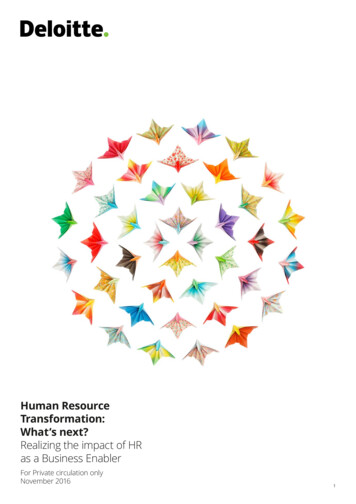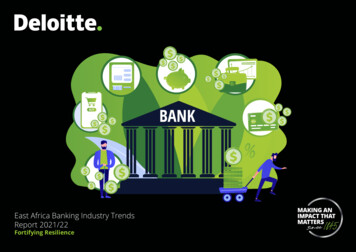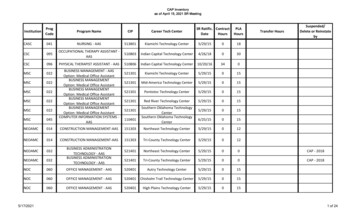
Transcription
Tech Trends 2015The fusion of business and ITTech Trends 2015The fusion of business and ITAn Insurance Industry Perspective
ContentsIntroduction 2CIO as chief integration officer 4API economy 22Ambient computing 38Dimensional marketing 56Software-defined everything 74Core renaissance 92Amplified intelligence 108IT worker of the future 126Exponentials 144Authors, contributors and special thanks 162
Tech Trends 2015: The fusion of business and ITIntroductionIT’S probably fair to say that consumers don’t view insurance companies as technological pioneerslike Apple Inc. or Google. The relationship between an insurer and its policyholders is typicallyinfrequent, fleeting, and transactional. It does not help consumers find an amazing restaurant,make a reservation at that restaurant, or get directions to the restaurant. The relationship is purely afleeting, financial interaction.Because of this historical interaction model, insurers have not needed to be at the leading edgeof information technology (IT). In fact, at a time when many other businesses have migratedfrom legacy systems to mobile and cloud solutions, insurers remain some of the largest users ofmainframe technology. But this is changing. A new wave of insight, or interactions, and value isbringing insurers and their personal and commercial customers closer together.Insurance, like many other industries, is facing sweeping changes driven by a confluence ofbusiness and technology forces fueled by innovation. Insurance companies understand they likelyneed to become more customer-focused, easier to do business with, more nimble, and increasinglyknowledge-rich. Insurers’ insatiable desire for more data to make better decisions and to reflect riskaccurately while simultaneously driving costs down never ends.Leaders in the marketplace are inventing new ways to link real observations with identificationof risk—which is the heart of the game: Telematics monitors automobile speed, acceleration, and overall driving safety to provide driversand insurers insight into truly high-risk—and low-risk—behaviors. The Internet of Things (IoT) will likely soon provide even more insight to how we live our livesin and around our homes. Wearable devices that track our physical activity and caloric intake can make us more aware ofthe daily decisions we make and its impact to our health.In short, the interconnectivity between insurance technology and consumers’ lives is increasingrapidly.To help make sense of it all, we offer Deloitte’s Sixth Technology Trends report, our annualin-depth examination of eight current technology trends, including the use of applicationprogramming interfaces to extend services and create new revenue streams; the dramatic impactconnectivity and analytics is having on digital marketing; and the evolving role of the chiefinformation office (CIO) to changing IT skills and delivery models.2
IntroductionThe theme for this year’s report is the fusion of business and IT, which is broadly inspired by afundamental transformation in the way C-Suite leaders and CIOs collaborate to leverage disruptivechange, chart business strategy, and pursue potentially transformative opportunitiesAn insurance focus: This version of the Technology Trends report highlights how each of theseeight current technology trends applies to and can impact insurance companies. Whether you are aproperty and casualty (P&C) insurer with less than 100 million in premiums, or the largest globallife and annuity (L&A) insurer—these trends are likely to affect you. Your various stakeholders—from internal leadership to external customers—will react to how your teams leverage andimplement the capabilities described by these trends.Each of the technology trends sections includes an “Insurance Perspective,” our view on howthe industry is grappling which each emerging trend. In some cases, insurance is a progressive,thoughtful leader. In others, the business case and application to insurance is still evolving.Either way, it’s an exciting time to be part of the insurance technology sector. We hope thisdocument delivers insight as to where we see insurance technology evolving and offers practicalapplications for you and your organizations.Best,Anthony AbbattistaInsurance TechnologyConsulting LeaderDeloitte Consulting LLPaabbattista@deloitte.comArun PrasadPrincipalDeloitte Consulting LLPaprasad@deloitte.comJohn MatleySenior ManagerDeloitte Consulting LLPjmatley@deloitte.com3
CIO as chief integration officerCIO as chiefintegration officerA new charter for ITAs technology transforms existing business models and gives rise tonew ones, the role of the CIO is evolving rapidly, with integration atthe core of its mission. Increasingly, CIOs need to harness emergingdisruptive technologies for the business while balancing future needswith today’s operational realities. They should view their responsibilitiesthrough an enterprise-wide lens to help ensure critical domains such asdigital, analytics, and cloud aren’t spurring redundant, conflicting, orcompromised investments within departmental or functional silos. Inthis shifting landscape of opportunities and challenges, CIOs can be notonly the connective tissue but the driving force for intersecting, IT-heavyinitiatives—even as the C-suite expands to include roles such as chiefdigital officer, chief data officer, and chief innovation officer. And whathappens if CIOs don’t step up? They could find themselves relegatedto a “care and feeding” role while others chart a strategic coursetoward a future built around increasingly commoditized technologies.FOR many organizations, it is increasinglydifficult to separate business strategyfrom technology. In fact, the future of manyindustries is inextricably linked to harnessingemerging technologies and disrupting portionsof their existing business and operatingmodels. Other macro-level forces such asglobalization, new expectations for customerengagement, and regulatory and compliancerequirements also share a dependencyon technology.As a result, CIOs can serve as the criticallink between business strategy and the ITagenda, while also helping identify, vet,and apply emerging technologies to thebusiness roadmap. CIOs are uniquely suitedto balancing actuality with inspiration byintroducing ways to reshape processes andpotentially transform the business withoutlosing sight of feasibility, complexity, and risk.But are CIOs ready to rumble? Accordingto a report by Harvard Business ReviewAnalytic Services, “57 percent of the businessand technology leaders surveyed view IT asan investment that drives innovation andgrowth.”1 But according to a Gartner report,“Currently, 51 percent of CIOs agree that thetorrent of digital opportunities threatens both5
Tech Trends 2015: The fusion of business and ITbusiness success and their IT organizations’credibility. In addition, 42 percent of thembelieve their current IT organization lacks thekey skills and capabilities necessary to respondto a complex digital business landscape.”2To remain relevant and become influentialbusiness leaders, CIOs should build capabilitiesin three areas. First, they should put theirinternal technology houses in order; second,they should leverage advances in science andemerging technologies to drive innovation;and finally, they need to reimagine their ownroles to focus less on technology managementand more on business strategy.In most cases, building these capabilitieswill not be easy. In fact, the effort will likelyrequire making fundamental changes tocurrent organizational structures, perspectives,and capabilities. The following approaches mayhelp CIOs overcome political resistance andorganizational inertia along the way: Work like a venture capitalist. Byborrowing a page from the venturecapitalist’s playbook and adopting aportfolio management approach to IT’sbalance sheet and investment pool, CIOscan provide the business with greatervisibility into IT’s areas of focus, its riskprofile, and the value IT generates.3 Thisapproach can also help CIOs develop achecklist and scorecard for getting IT’shouse in order. Provide visibility into the IT “balancesheet.” IT’s balance sheet includes programsand projects, hardware and softwareassets, data (internal and external, “big”and otherwise), contracts, vendors, andpartners. It also includes political capital,organizational structure, talent, processes,and tools for running the “business of IT.”Critical to the CIO’s integration agendais visibility of assets, along with costs,resource allocations, expected returns,risks, dependencies, and an understandingof how they align to strategic priorities.6 Organize assets to address businesspriorities. How well are core IT functionssupporting the day-to-day needs ofthe business? Maintaining reliablecore operations and infrastructure canestablish the credibility CIOs need toelevate their missions. Likewise, spottyservice and unmet business needs canquickly undermine any momentum CIOshave achieved. Thus, it is important tounderstand the burning issues end usersface and then organize the IT portfolio andmetrics accordingly. Also, it’s important todraw a clear linkage between the balancesheet, today’s operational challenges,and tomorrow’s strategic objectives inlanguage everyone can understand. As IntelCIO Kim Stevenson says, “First, go afteroperational excellence; if you do that well,you earn the right to collaborate with thebusiness, and give them what they reallyneed, not just what they ask for. Master thatcapability, and you get to shape businesstransformation, not just execute pieces ofthe plan.” Focus on flexibility and speed. Thebusiness wants agility—not just in the waysoftware is developed, but as part of moreresponsive, adaptive disciplines for ideating,planning, delivering, and managing IT.To meet this need, CIOs can direct someportions of IT’s spend toward fuelingexperimentation and innovation, managingthese allocations outside of rigid annualbudgeting or quarterly planning cycles.Business sponsors serving as productowners should be embedded in projectefforts, reinforcing integration betweenbusiness objectives and IT priorities. Agilitywithin IT also can come from bridgingthe gap between build and run—creatingan integrated set of disciplines under thebanner of DevOps.4For CIOs to become chief integrationofficers, the venture capitalist’s playbook
CIO as chief integration officerNew boardroom discussionsWith digital now a key boardroom topic, companies are addressing new technology needs in different ways. A recentForrester survey found that “37 percent of firms place ownership of digital strategy at the ‘C’ level, with a further44 percent looking to a senior vice president (SVP), executive vice president (EVP), or similar role to direct digital plans.However, less than a fifth of firms have or plan to hire a chief digital officer (CDO), meaning that digital accountabilitylives with an incumbent role.” a CIOs can either fill these new digital needs themselves or serve as the connective tissueintegrating all tech-related positions.cioceo Shaping business strategyinfused with technology—advising and executing on realitiesof existing capabilities, and thepotential of emerging trends.chief digital officer Collaboratingto define a vision and roadmap,provide integration, security, anddata services, and drive sustainableroll-out of digital services.cfo Framing initiative investments,operations, delivery, and budget interms of risk management andreturn on assets.chief data officer Planning andexecution of new capabilities andgovernance of internal, external,structured, and unstructured datasources and surrounding tools.coo Understanding, prioritizing,and addressing pain points andinefficiencies in analytics, businessprocesses, and operations—retooling how work gets done.chief innovation officer Seedingtechnology-based innovation ideaswhile complementing the “art ofthe possible” with the “realitiesof the feasible.”cmo Partnering to implement newmarketing tools with hooks intoback-office data and transactions,while retooling to offer agiledelivery for new digital solutions.chief customer officer Definingcustomer personas and journeysand exploring how experiencescan be improved via existing andemerging technology.chairperson Elevating technology to the boardroom agenda, represented as a strategicasset for profitability, effective and efficient operations, and growth.Source: a Martin Gill, Predictions 2014: The Year Of Digital Business, Forrester Research, Inc., December 19, 2013.7
Tech Trends 2015: The fusion of business and ITcan become part of the foundation of thistransformation—setting up a holistic view ofthe IT balance sheet, a common language foressential conversations with the business, anda renewed commitment to agile execution ofthe newly aligned mission. These capabilitiesare necessary given the rapidly evolvingtechnology landscape.Harness emerging technologiesand scientific breakthroughsto spur innovationOne of the most important integrationduties is to link the potential of tomorrowto the realities of today. Breakthroughs arehappening not just in IT but in the fields ofscience: materials science, medical science,manufacturing science, and others. TheExponentials at the end of this report shinea light on some of the advances, describingpotentially profound disruption to business,government, and society. Create a deliberate mechanism forscanning and experimentation. Defineprocesses for understanding the “what,”distilling to the “so what,” and guidingthe business on the “now what.” AsPeter Drucker, the founder of modernmanagement, says, “innovation is work”—and much more a function of the importingand exporting of ideas than eurekamoments of new greenfield ideas.5 Build a culture that encourages failure.Within and outside of IT, projects withuncharted technologies and unproveneffects inherently involve risk. To thinkbig, start small, and scale quickly,development teams need CIO supportand encouragement. The expression“failing fast” is not about universalacceptance and celebrating failure. Rather,it emphasizes learning through iteration,with experiments that are designed to yieldmeasurable results—as quickly as possible.68 Collaborate to solve tough businessproblems. Another manifestation of“integration” involves tapping into newecosystems for ideas, talent, and potentialsolutions. Existing relationships withvendors and partners are useful on thisfront. Also consider exploring opportunitiesto collaborate with nontraditional playerssuch as start-ups, incubators, academia,and venture capital firms. Salim Ismail,Singularity University’s founding executivedirector, encourages organizations to try toscale at exponential speed by “leveragingthe world around them”—tapping intodiverse thinking, assets, and entities.7An approach for evaluating new technologymight be the most important legacy a CIOcan leave: institutional muscle memory forsifting opportunities from shiny objects,rapidly vetting and prototyping new ideas,and optimizing for return on assets. Theonly constant among continual technologyadvances is change. Providing focus and clarityto that turmoil is the final integration CIOsshould aspire to—moving from potential toconfidence, and from possibility to reality.Become a business leaderThe past several years have seen newleadership roles cropping up across industries:chief digital officer, chief data officer, chiefgrowth officer, chief science officer, chiefmarketing technology officer, and chiefanalytics officer, to name a few. Each role isdeeply informed by technology advances,and their scope often overlaps not only withthe CIO’s role but between their respectivecharters. These new positions reflectburgeoning opportunity and unmet needs.Sometimes, these needs are unmet because theCIO hasn’t elevated his or her role to take onnew strategic endeavors. The intent to do somay be there, but progress can be hamperedby credibility gaps rooted in a lack of progresstoward a new vision, or undermined byhistorical reputational baggage.
CIO as chief integration officer Actively engage with business peers toinfluence their view of the CIO role. Fororganizations without these new roles,CIOs should consider explicitly stating theirintent to tackle the additional complexity.CIOs should recognize that IT may have ahard time advancing their stations withouta positive track record for delivering core ITservices predictably, reliably, and efficiently. Serve as the connective tissue to all thingstechnology. Where new roles have alreadybeen defined and filled, CIOs shouldproactively engage with them to understandwhat objectives and outcomes are beingframed. IT can be positioned not just asa delivery center but as a partner in thecompany’s new journey. IT has a necessarilycross-discipline, cross-functional, crossbusiness unit purview. CIOs acting as chiefintegration officers can serve as the gluelinking the various initiatives together—advocating platforms instead of pointsolutions, services instead of brittle pointto-point interfaces, and IT services fordesign, architecture, and integration—whilealso endeavoring to provide solutions thatare ready for prime time through security,scalability, and reliability.9
Tech Trends 2015: The fusion of business and ITInsurance Industry PerspectiveAnthony AbbattistaThe insurance company CIO naturallyresides in a conflicted position. In atraditionally risk-adverse industry, separatingone’s organization from the technologicalstatus quo brings internal and externalchallenges. As users of technology, insurers aretypically viewed as “laggards” and “followers”when compared with companies in moretechnologically progressive industries, suchas IT and consumer products. In spite of thisless-than-stellar starting point, the insuranceCIO has an opportunity to leverage emergingcapabilities as a rallying point to drivemeasurable business outcomes.A knowledgeable workforceThe insurance CIO often leads a workforcethat understands the core business andoperations more comprehensively andcompletely than their business counterparts.The focus over the past 20 years of automatingrating and straight-through-processinghas given the average IT employee a deepunderstanding of the underlying businessand its key drivers. The intimate, hands-onexperience has resulted in a workforce that iscritical to balancing the business’s needs anddesires with reality.To fully tap into the knowledge of theIT workforce, insurers should continueto embrace creative approaches. Creatingvenues and time for innovation with theirbusiness colleagues can unleash creativitythat would otherwise be untapped. Insurershave embraced more traditional SiliconValley concepts like app-a-thons, innovationchallenges, and crowdsourcing withuniversities and other institutions to drivemore proactive idea development.10Insurance has, and will continue to be, ahighly competitive and saturated market. Theinsurance CIO as chief integration officerrecognizes that the intersection of diverseperspectives and experience can be used tooutperform the competition.Data continues to be kingThe insurance CIO and their team typicallyhold the keys to the data kingdom becausethey are the guardians of often-underutilizedcorporate assets in the form of operational,competitive, and financial data. InsuranceCIOs, system architects, and data scientistshave an opportunity to turn data into use cases—creating insight rather than supporting it.Given the proliferation and affordability ofbig-data environments and visualization tools,there is little excuse to not have a sandboxenvironment that nurtures the curious spirit—a place where “What if,” “I wonder how,” and“I wonder what” are easily tested and vettedagainst the context of data that doesn’t lie.The insurance CIO as chief integrationofficer can create an environment where data,technology, and people become interactive,collaborative, and accretive.Unlimited transparencyand foresightDue to regulatory and reporting needs, thelinkage between sales (premiums) and costs(losses) are inexorably tied in an insurancecompany. Decades of investment in financialmanagement have resulted in a tightly knit,well-documented flow of debits and creditswithin the insurance company. As a result,the insurance CIO can see most capitalexpenditures, as well as the connectivity
CIO as chief integration officerbetween diverse and seemingly unrelatedprograms, and create an environment oftransparency and controllable levers thatsupports their counterparts in making wiseinvestments in their business functions.With this insight, the insurance CIO hasthe opportunity to come to the table not asthe “technology guy,” but as a partner to thebusiness leads. He or she can call it like it isand create foresight as a business partner,innovator, and devil’s advocate. There is powerin being able to step back and provide thatbusiness-agnostic view to the leadership table.CIO as venture capitalistThe exciting opportunity aheadWhile the trains need to run on time andoperational excellence is a necessary conditionfor success, most insurers are crying out forinnovative IT leadership to help propel themto a better future. As outlined above, theinsurance CIO has access to resources andknow-how that are often untapped. Movingdeeply entrenched and static organizationsto think and behave differently undoubtedlyrequires finesse and the ability to lead throughinfluence not through structure and might.CIOs who embrace the opportunities andleverage the wind at their back can positiontheir organizations for continued success.As the leader of one of the single largest costcenters in a company (bested only by claimsand, in consumer lines of business, marketing),the insurance CIO has the opportunity tocreate seed funding for initiatives that crossboundaries and accomplish higher-purposedobjectives.As a person with a substantial amountof fiscal discretion, the insurance CIO canaggregate small decisions and small wins tobuild a veritable war chest for innovation.Working in partnership with the chief financialofficer (CFO), the insurance CIO as chiefintegration officer may want to fund andthereby encourage a substantial number ofinitiatives that bring people, technology, andideas together to do things that would likelynever make the cut in the yearly budgetingcycle. This is truly taking the role of CIO asventure capitalist to heart.11
Tech Trends 2015: The fusion of business and ITLessons from the front linesLook inside ITWhen asked recently about the proliferationof chiefs in the C-suite—chief digital offer,chief innovation officer, etc.—and the ideathat CIOs could assume the role of “chiefintegration officer” by providing the muchneeded connective tissue among manyexecutives, strategies, and agendas, Intel Corp.’sCIO Kim Stevenson offered the followingopinion: “The CIO role is unique in that itis defined differently across companies andindustries. No two CIOs’ positions are thesame, as opposed to chief financial officers,legal officers, and other C-suite roles. Idon’t like it when people try to rename theCIO role. It contributes to a general lack ofunderstanding about the role—and about whatcompanies should expect from their CIOs.”Monikers aside, Stevenson occasionallyoffers the following advice to CEOs andboards who are pondering the future amidtremendous technology-driven disruption: “Ifyou need all those C-suite roles, you probablydon’t have the right CIO.”The “right CIO” is one who first achievesoperational excellence by keeping the lightson, all critical IT positions filled, and allsystems running at peak performance. AtIntel, operational excellence of core businessprocesses—satisfying day-to-day needs—hasearned IT the right to collaborate with businessleaders to identify solutions needed to achievetheir goals.It is through such collaboration thatCIOs can elevate and broaden their roles.That means working with business leadersto not just give them what they ask for buthelping them figure out what they reallyneed. “Your internal customers have to wantwhat IT is selling,” Stevenson notes, and toachieve this, CIOs should work with businessleaders to create shared objectives and to12expand expectations beyond incrementalimprovements to helping drive transformation.In one meeting with a senior vice president(SVP), Stevenson received the feedback: “We’rehappy with everything you are doing rightnow.” When Stevenson and the SVP discussedwhere the function was strategically headed,several critical efforts were identified—newcapabilities that likely couldn’t be deliveredwithout IT. Because of the trust earnedthrough more tactical collaboration, a moreambitious set of priorities was agreed upon.Intel also tries to measure IT’s success noton its ability to provide a needed solution bya specific deadline but on the shared outcomeof the initiative. The goal is for IT and itscustomer to be held responsible for achievingthe same outcome—aligning priorities,expectations, and incentives.Finally, through collaboration defined byshared objectives and outcomes, CIOs earnthe right to influence how their companieswill take advantage of disruptive change.At Intel, Stevenson recognized such anopportunity with the company’s mobilesystem-on-a-chip (SOC). The team lookedat the product life cycle, from requirementsto production, analyzing the entire processto understand why it took so long to get thecompany’s SOCs to market compared withcompetitors. Working closely with businessunits and the organization that overseesSOC production, Stevenson and her IT teamidentified bottlenecks and set their prioritiesfor increasing throughput. The business unitschose 10 SOCs to focus on, and IT came upwith a number of improvements, ranging frombasic (determining whether there was enoughserver space for what needed to be done) tocomplex (writing algorithms).The outcome of this collaborative effortexceeded expectations. In 2014, the company
CIO as chief integration officersaw production times for the targeted SOCproducts improve for one full quarter, in somecases for almost two. “That was huge for us,”said Stevenson. “The SOC organization sethigh expectations for us, just as we did forthem. In the wake of our shared success, theirview of IT has gone from one of ‘get out of myway’ to ‘I never go anywhere without my ITguys.’”From claims to innovationLike many of its global peers, AIG facescomplex challenges and opportunities as thedigital economy flexes its muscles. At AIG, ITis viewed not just as a foundational elementof the organization, but also as a strategicdriver as AIG continues its transformationto a unified, global business. AIG’s CEO,Peter Hancock, is taking steps to integrate thecompany’s IT leaders more deeply into how itsbusinesses are leveraging technology. Shortlyafter assuming his post, Hancock appointeda new corporate CIO who reports directly toHancock and chairs the company’s innovationcommittee. Previously, the top IT role reportedto the chief administration officer.AIG’s claim processing system, OneClaim ,is emblematic of the more integrated role ITleaders at the company can play. Peter Beyda,the company’s CIO for claims, is replacingAIG’s many independent claims systems with acentralized one that operates on a global scale.The mandate is to be as global as possible whilebeing as local as necessary. Standardized dataand processes yield operational efficienciesand centralized analytics across productsand geographies. However, IT also respondsto the fast-paced needs of the business. InChina, for example, package solutions wereused to quickly enter the market ahead of theOneClaim deployment—reconciling data inthe background to maintain global consistencyand visibility. AIG has deployed OneClaimin 20 countries and anticipates a full globalrollout by 2017. The project is raising theprofile of IT leadership within the companyand the critical role these leaders can play indriving enterprise innovation efforts.The OneClaim system also forms thefoundation for digital initiatives, frommobile member services to the potentialfor augmenting adjustors, inspectors, andunderwriters with wearables, cognitiveanalytics, or crowdsourcing approaches.IT is spurring discussions about the “art ofthe possible” with the business. OneClaimis one example of how AIG’s IT leadershipis helping define the business’s vision fordigital, analytics, and emerging technologies,integrating between business and IT silos,between lines of business, and between theoperating complexities of today and theindustry dynamics of tomorrow.Digital mixologyLike many food and beverage companies,Brown-Forman organizes itself by productlines. Business units own their respectiveglobal brands. Historically, they workedwith separate creative agencies to drive theirindividual marketing strategies. IT supportedcorporate systems and sales tools but was nottypically enlisted for customer engagement orbrand positioning activities. But with digitalupending the marketing agenda, BrownForman’s CIO and CMO saw an opportunity toreimagine how their teams worked together.Over the last decade, the companyrecognized a need to transform its IT andmarketing groups to stay ahead of emergingtechnologies and shifting consumer patterns.In the early 2000s, Brown-Forman’s separateIT and marketing teams built the company’sinitial website but continued to conductcustomer relationship management (CRM)through snail mail. As social media beganto explode at the turn of the decade, BrownForman’s marketing team recognized thatclosely collaborating with IT could be thewinning ingredient for high-impact, agile13
Tech Trends 2015: The fusion of business and ITmarketing. While the external marketingagencies that Brown-Forman had contractedwith for years were valuable in deliveringcreative assets and designs, marketing nowneeded support in new areas such as managingwebsites and delivering d
In some cases, insurance is a progressive, thoughtful leader. In others, the business case and application to insurance is still evolving. Either way, it's an exciting time to be part of the insurance technology sector. We hope this document delivers insight as to where we see insurance technology evolving and offers practical











